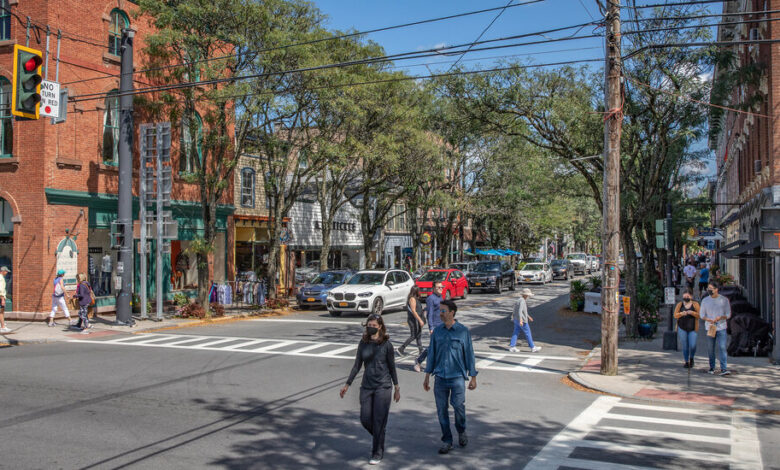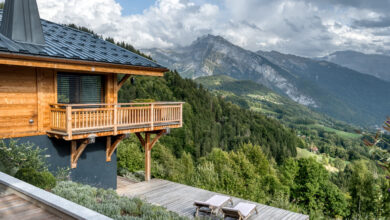Rhinebeck, N.Y.: A Historic Community With Cultural Amenities

[ad_1]
Gary Bassett moved to Rhinebeck, N.Y., in 1993, after being transferred by his employer, IBM, from Wisconsin to a plant in nearby Kingston. The village of about 2,600 residents in the Hudson Valley reminded him and his wife, Brenda Bassett, of their small hometown in central Pennsylvania, and they felt an immediate kinship with the place.
They’ve now lived there for nearly 30 years, which would make you an old-timer in most places. But Rhinebeck has a 300-plus-year history, and a long memory.
The village of Rhinebeck — which sits inside the town of Rhinebeck, like “the hole within the doughnut,” Mr. Bassett said — is home to one of the oldest operating inns in the country, Beekman Arms & Delamater Inn. And houses there are known not by the people who live in them today, but by those who lived in them a century ago. Both town and village are within the Hudson River Historic District, which includes more than 40 riverfront estates and, at 32 square miles, is one of the largest historic districts in the country.
“I know people who have lived their whole lives here,” said Mr. Bassett, who is mayor of the village. “The residents of Rhinebeck take a lot of pride. We work hard to keep that historic preservation alive.”
At the same time, he added, “there’s that transition of new people coming in. The area is changing.”
Locals cite the wedding of Chelsea Clinton, in 2010, at a village estate once owned by John Jacob Astor IV, as a turning point. Rhinebeck went from what Catherine A. Mondello, a local realtor, called “a laid-back country town, a Mayberry,” to a popular destination for day-trippers up from New York City, as well as a community where retirees and younger urbanites choose to relocate.
“Since then, we’ve just seen the trend moving up,” Ms. Mondello, the owner and principal broker of Mondello Upstate Properties, said. “The village is bustling.”
Vanessa Bertozzi and her husband, Mickey Duzyj, are two recent transplants. The couple had been living in Red Hook, Brooklyn, where she worked for Etsy and he pursued a career as a filmmaker. But their apartment felt cramped after their second child was born, and Etsy, which has an office in Hudson, N.Y., offered Ms. Bertozzi the opportunity to move upstate.
The couple chose Rhinebeck because the public schools are good and because it gave their two sons a version of the small-town childhood that Ms. Bertozzi experienced in New England. In 2017, the couple paid $430,000 for a four-bedroom, two-and-a-half-bathroom home in a newer subdivision in the village. That looks like a bargain now, as Rhinebeck, like many upstate towns, has experienced soaring housing prices during the pandemic.
“It’s not a beautiful home, but because we got a good price, we’ve been able to redo stuff,” Ms. Bertozzi said. “We redid the deck and the front porch to give it more curb appeal. That’s been fun as first-time homeowners.”
Ms. Bertozzi has had little trouble adapting to life outside the city. Rhinebeck Village has ample cultural amenities, including a bookstore, a movie theater and two public libraries, while the town offers wide-open farmland, winding country roads and the Hudson River, which runs along its western border.
“Everyone takes such wonderful care of their gardens. There are tree-lined streets here,” Ms. Bertozzi said. “It’s a place that’s really proud of its beauty. It’s just a very attractive village.”
What You’ll Find
The village of Rhinebeck, at the center of the town, is small but vibrant and lively, especially on weekends. Packed into its 1.53 square miles are nearly two dozen restaurants; the well-known bakery Bread Alone; a high-end spa, Mirbeau Inn & Spa; several art galleries and clothing shops; and a candy store, Samuel’s Sweet Shop, co-owned by the actors Paul Rudd and Jeffery Dean Morgan. On a recent visit, there was hardly a vacant storefront.
The Beekman Arms, with its white-brick facade, black shutters and landscaped front yard, stands regally on a prominent corner as you enter the village. On the streets behind the business district are beautifully preserved old houses. There is a noticeable sophistication and wealth to Rhinebeck that you don’t find in some neighboring towns — it’s a quaint upstate village polished to a high shine.
Lydia Slaby, a writer and village trustee who moved to the area in 2018, called the village “the center of gravity” for the more rural town and surrounding countryside. (The traffic certainly makes it feel like a crossroads.) Ms. Slaby followed her sister, who had bought a 17-acre farm in the town, and her aging parents, who moved to a cottage on the property. She and her husband, Michael Slaby, an executive at a nonprofit, had been living in Chicago and first visited Rhinebeck on a snowy day at Christmastime, in 2011.
“I thought it was beautiful up here. It’s like wandering around in a painting — which makes sense, because there was that whole painting school,” Ms. Slaby said, referring to the Hudson River School movement. “Everyone was saying ‘hi’ to each other. This is an actual community.”
The couple rented an 1883 Victorian on half an acre, a five-minute walk from the center of the village, and ended up buying it. Ms. Slaby, who grew up on Capitol Hill in Washington, D.C., had never envisioned living outside a big metro area. But now, she said, “We’re never going anywhere again. We’re an hour and a half from New York City. We both work remotely. Why would we ever leave?”
It is a point of pride for Mr. Bassett that Rhinebeck doesn’t have big-box stores, though he noted that there is a supermarket “out on the edge of the village.” The city of Kingston, directly across the river, provides locals with more food shopping options, along with a Home Depot, Walmart Supercenter and other chain retailers.
What You’ll Pay
In July, the average sale price of homes in the village was $859,000, a 39 percent increase over September 2020, according to data provided by Mondello Upstate Properties. The average sale price for a home in the village in 2019 was $545,000.
Aside from price escalations, the main challenge for buyers is very low inventory, especially in the village, which is where many city transplants want to live. The village is pretty much built out, and with strict zoning regulations, new homes are not being added.
“I have a client who is coming from Brooklyn — her daughter is a teenager, she wants to be in town,” said Adelia Geiger, a broker with Gary DiMauro Real Estate. “And I can’t find them anything in the town. I can find them outside of town, but she doesn’t want to do that.”
The housing stock in the village is a mix of colonials, Victorians and Tudors, along with a few newer subdivisions and modest starter homes. Around $350,000 will get you “a basic two-bedroom, one-bath, on a quarter of an acre on the outskirts,” Ms. Mondello said. “If you want to buy a turnkey home with all the bells and whistles, you’re going to be paying at least $1.5 million.”
As of Sept. 2, listings ranged from a three-bedroom, two-bathroom 1837 Victorian, priced at $599,000, to an 1860s Victorian on a coveted street in the village, with a Wolf stove and stainless-steel appliances, priced at $1.5 million, with annual property taxes of $20,114.
Since the pandemic, homes frequently sell above the asking price, sometimes sight unseen and after a bidding war. “For some people,” Ms. Mondello said, “money is no object. We’ve seen a lot of that up here.”
The Vibe
The mix of small-town community and access to New York City has drawn many retirees to Rhinebeck. Richard McKeon, the rector at the Episcopal Church of the Messiah in the village, said that younger retirees in their 60s find Rhinebeck an engaging community.
“It’s a community that’s perceived as affluent, but it’s a community that has a big commitment to social justice,” Father McKeon said. “People bring a lot of their gifts to the community and want to give back. It’s fantastic for the parish. It doesn’t seem like a sleepy retirement village.”
As someone who moved from New York City, Ms. Bertozzi said, “I wouldn’t say it’s edgy. It’s very peaceful, with a little bustle on the weekends.”
For years, as the population aged, attendance at the local schools fell, putting the school system “on a slow and steady decline,” Mr. Bassett said. But as young families like Ms. Bertozzi’s have moved to the community, especially during the pandemic, that trend has started to reverse, and Rhinebeck once again feels like a community of families.
Now gentrification and housing affordability are a concern for local leaders in the village, but as Father McKeon said, “The town is really wide open. People can find their way without displacing other people.”
The Schools
“The school system is a big draw,” said Ms. Geiger, the realtor. “You want a good school system, and Rhinebeck has one.”
Ms. Bertozzi, whose two sons are enrolled in the local schools, said: “The teachers and administration really care about the community.”
Children in both the town and the village attend schools in the Rhinebeck Central School District. During the 2020-21 school year, enrollment at Rhinebeck High School totaled 321. The graduation rate was 90.2 percent, compared with 83.4 percent statewide. And the average SAT scores were 580 in math and 568 in verbal, compared with statewide averages of 530 and 528, according to Whitney Druker, secretary to the superintendent for the school district.
The Commute
One of the advantages of Rhinebeck, compared with other upstate communities, is its proximity to an Amtrak station, at Rhinecliff, two miles from the village. The trip to Manhattan takes around an hour and a half, and costs $30 to $71 one way, $336 for a 10-trip pass or $756 a month.
Mr. Slaby commutes twice a week and uses his seat as a mobile office. “He considers his commute the six-minute drive to the station,” Ms. Slaby said.
The 100-mile drive to the city takes about two hours, depending on traffic.
The History
When violets became a fashionable flower during the Gilded Age, appearing in wedding bouquets and corsages worn at Harvard-Yale football games, an industry emerged around Rhinebeck to fuel the trend.
“Dutchess County was considered the ‘violet belt,’” wrote Hudson Valley magazine in 2012, “with Rhinebeck its buckle. The town was known as the Violet Capital of the World; its major growers — known as the Violet Kings — and smaller producers supplied about 25 percent of the nation’s violets.”
Last summer, town officials unveiled a history marker commemorating Rhinebeck’s flower-growing past. It sits on Route 9G, the main road connecting Rhinebeck to neighboring violet-belt communities like Hyde Park and Red Hook. The roadway was once known as Violet Avenue.
For weekly email updates on residential real estate news, sign up here. Follow us on Twitter: @nytrealestate.
[ad_2]
Source link






